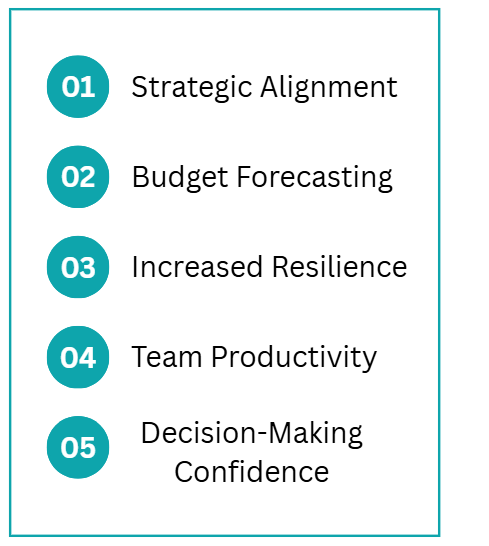Subscribe to Receive Updates
Join hundreds of business leaders and get our perspective on critical issues delivered to your inbox..

Technology is at the core of every modern business, but how often do you actually stop to evaluate whether your systems are performing as they should? For many small and mid-sized businesses (SMBs), the answer is not often enough.
Our thirtyone3 technology team has seen firsthand how many organizations operate with a false sense of security, assuming their IT infrastructure is “good enough” until a cyber incident, system failure, or growth bottleneck forces a painful reality check. This is precisely what makes an IT assessment so essential; especially at critical planning points like mid-year.
An IT assessment is a structured, strategic evaluation of your entire technology environment. It’s like a health check for your IT ecosystem—designed to identify gaps, inefficiencies, and vulnerabilities before they become disruptive.
It’s important to distinguish an IT assessment from two related but different practices:
An IT assessment is broader and more holistic. It considers how all elements of your tech stack work together, where breakdowns are likely to occur, and what needs to be optimized.
While the specific scope can vary by business size or industry, most assessments include:
Each of these components works together to tell a story about how effectively—and securely—your business is operating.
One often overlooked benefit of an IT assessment is regulatory preparedness. With data privacy laws tightening and cyberthreats evolving, SMBs can’t afford to overlook compliance. In fact, as noted in CompTIA’s guide to cybersecurity compliance, falling out of compliance can lead not only to fines, but also reputational damage and lost customer trust.
Regular IT assessments allow businesses to stay ahead of these risks—ensuring your tech stack is not only functional but aligned with evolving standards.
If you’re running a small or mid-sized business, chances are you don’t have the luxury of a massive IT team, or the margin for downtime. Every decision you make around technology impacts operations, employee productivity, and customer satisfaction. That’s why overlooking regular IT assessments can quietly introduce risk into your business long before it surfaces as a major problem.
As businesses scale, their technology environments become more complex, often in ways that aren’t immediately obvious. What starts as a few well-placed apps and cloud subscriptions can grow into a tangled web of redundant systems, unpatched software, and shadow IT (software used without explicit approval).
This unmanaged sprawl is one of the most common issues we uncover at thirtyone3 technology during mid-year assessments. It creates blind spots; places where data might be unsecured, integrations might fail, or performance might suffer without warning.
In many cases, cybersecurity threats arise when IT updates are not properly managed or communicated, which is why change management must be an intentional part of your assessment strategy. When updates are rushed or implemented without clear protocols, they often introduce vulnerabilities instead of resolving them. This poses a key risk that mid-year reviews can proactively prevent.
Why conduct an IT assessment in the middle of the year instead of waiting until Q4? Because mid-year is when your business is likely transitioning from reactive problem-solving to proactive planning. It’s a strategic sweet spot for identifying what’s working, what’s lagging, and what needs to change before the end-of-year push.
Here’s what a mid-year IT assessment can deliver:

The truth is, businesses that leverage accurate data to inform decision-making are far better positioned to adapt and scale effectively. That insight isn’t just anecdotal—it’s backed by findings that show how good data practices empower more confident and timely business strategies.
Many businesses wait until the end of the year to review their IT strategies. Budgets are tight, staff are stretched thin, and system demands are at their peak. But by then, it’s often too late to course-correct effectively. That’s why mid-year IT assessments are not just smart, they’re strategic.
Mid-year marks a critical transition point in the business calendar. It’s when organizations step back from the Q1 grind, review their performance against goals, and adjust for the second half. It’s also when leadership teams begin laying the groundwork for next year’s budgeting and strategic plans.
An IT assessment conducted now helps ensure your technology infrastructure is:
Rather than playing catch-up in Q4, you’re able to proactively refine your IT roadmap with six months of data and insight behind you.
Here’s something we’ve learned over the years at thirtyone3 technology: even the most well-architected IT environment can drift. What starts the year as a finely tuned operation may slowly degrade due to user behavior, incremental changes, overlooked patches, or usage shifts.
By mid-year, that drift can manifest in:
A mid-year IT assessment helps recalibrate your systems before these issues start affecting customer experiences or internal productivity. It’s like tightening the bolts before the engine starts rattling.
In one recent engagement, a mid-year assessment revealed that a client’s cloud storage solution had quietly exceeded its capacity threshold. They were days away from service degradation; but early detection saved them time, money, and a scramble under pressure.

One of the biggest misconceptions among small and mid-sized business owners is that IT assessments have to be handled in-house. And while internal IT teams certainly have a role to play, there’s a compelling case for bringing in outside expertise when clarity and objectivity matter most.
Internal IT teams are often stretched thin managing daily tickets, troubleshooting, and deploying new tools. This makes it difficult for them to step back and critically assess their own environment. Familiarity, while valuable, can also breed blind spots.
By contrast, third-party IT professionals offer a fresh set of eyes and specialized tools designed to identify risks, inefficiencies, or misalignments that may be hidden in plain sight.
At thirtyone3 technology, our IT assessments bring together multiple lenses:
These are questions that require perspective, and that’s hard to maintain when you’re too close to the day-to-day details.
If you’re considering a third-party partner for your assessment, here are a few key qualities to prioritize:
Ultimately, your IT assessment partner should function like a co-pilot; someone who not only helps you spot turbulence ahead but also helps you navigate through it with confidence.
At thirtyone3 technology, we know firsthand that small and mid-sized businesses can’t afford to treat IT like a background utility. Your technology is the engine that drives growth, agility, and security. That’s why our IT assessments are designed to deliver more than just diagnostics. We deliver clarity, strategy, and momentum.
We take a hands-on approach with every assessment. It’s not about running automated scans and sending over a PDF. It’s about listening to your goals, reviewing your systems in context, and helping you turn insights into action.
Our process includes:
And we don’t stop there. If you choose to act on our recommendations, we’re equipped to help implement those changes quickly and seamlessly, minimizing downtime and disruption.
We’ve found that clients who schedule their assessments in Q2 or Q3 gain a critical edge. With half the year behind them and half the year ahead, they can course-correct with purpose and speed. They can secure budgets, prepare for year-end demands, and align their IT strategy with growth goals before it’s too late to pivot.
Our assessments have uncovered hidden bottlenecks, corrected security vulnerabilities, and helped business owners reclaim control over their technology environments. If you’ve never had an external team take a look under the hood, now is the time.
The best time to fix your IT issues is before they become business problems. A mid-year IT assessment is your opportunity to do just that. Step back, evaluate your environment, and make informed adjustments before the high-stakes rush of Q4.
Right now. Mid-year is ideal because:
Waiting until things “feel off” is like waiting for a flat tire before checking your pressure. A proactive assessment doesn’t just save you stress, it saves you money, reputation, and time.
If you’re considering a mid-year IT checkup, here’s what to do:

We’ll walk you through what to expect, what we’ll need from your team, and what deliverables you’ll receive. From start to finish, our process is built to be clear, actionable, and aligned with your goals.
Technology should move your business forward, not hold it back. A mid-year IT assessment gives you the insights and control you need to finish the year stronger than you started. Whether you’re chasing growth, tightening up operations, or just trying to sleep better at night, it all starts with knowing where you stand.
Explore these trusted resources to dive deeper into the topics covered in this article:
CompTIA – Compliance in Cybersecurity: What You Need to Know to Stay Ahead of Regulations
Understand the evolving regulatory landscape and how SMBs can stay compliant through proactive cybersecurity planning.
Forbes Business Council – Why Good Data Is Critical to Making Informed Business Decisions
A breakdown of how strategic decisions depend on accurate, timely IT data—and why poor data visibility is a hidden liability.
thirtyone3 technology – Change Management in Cybersecurity: Stop IT Updates from Becoming Your Biggest Cyber Risk
Discover how overlooked updates can become major vulnerabilities—and what a structured change process can do to protect your business.
Join hundreds of business leaders and get our perspective on critical issues delivered to your inbox..